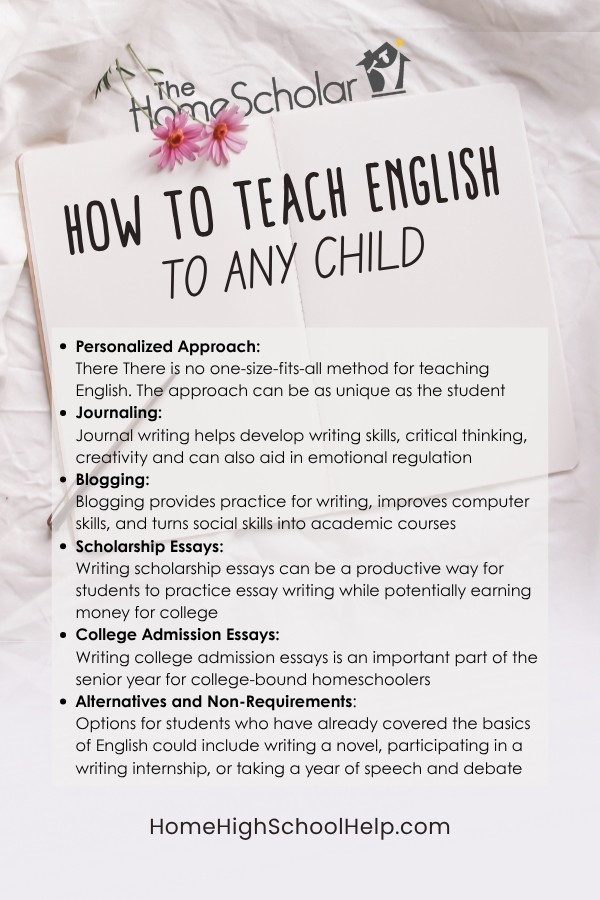How to Teach English to Any Child
There is a lot of debate in the homeschool community on if there is a "right way" to teach English. An effective homeschool English class for middle school and high school can be as unique as your student.
There is no one-size-fits-all writing program, no perfect reading lists, just as there are no cookie-cutter homeschoolers. English doesn't always require curriculum. Sometimes you need to start gently, easing them into writing. And once your child knows how to write, you can use every day, real world writing. Here are four fun ideas you can try and some optional courses that may surprise you.
Journaling
Journal writing is a great way for students (especially middle schoolers) to practice writing skills when developing their own "voice." With regular, daily, or weekly writing, it can make up a whole credit or help boost an existing credit. For journal writing, the goal is to improve your student's writing fluency, boost critical thinking and creativity, and aid in emotional regulation.
In high school, it's not unusual for students to write a longer paper and/or practice essay writing each week. For those assignments, it's worth correcting grammar, punctuation, and style, but in a personal journal, it's probably not necessary to edit their work. As your students get older, they may want to keep their journals private. The goal is routine writing. Some students thrive with a prompt to guide them, and others only feel fenced in by prompts and would prefer to write more freely. Rather than guide the topic, guide how much or how quickly they write. These skills can be important later for longer or timed essays.
If you are walking through a crisis year, daily journaling is an excellent way for students to stay caught up with English requirements AND process the chaos in their world. Handwriting helps students slow down and actually think about the words, which encourages deeper emotional processing and focus.
A class primarily made of hour-long, daily journaling sessions could be called "Creative Writing and Journaling" or "English Composition through Journaling." If you do end up using journal entries for credit or as work samples, I recommend dating each entry.
In high school, it's not unusual for students to write a longer paper and/or practice essay writing each week. For those assignments, it's worth correcting grammar, punctuation, and style, but in a personal journal, it's probably not necessary to edit their work. As your students get older, they may want to keep their journals private. The goal is routine writing. Some students thrive with a prompt to guide them, and others only feel fenced in by prompts and would prefer to write more freely. Rather than guide the topic, guide how much or how quickly they write. These skills can be important later for longer or timed essays.
If you are walking through a crisis year, daily journaling is an excellent way for students to stay caught up with English requirements AND process the chaos in their world. Handwriting helps students slow down and actually think about the words, which encourages deeper emotional processing and focus.
A class primarily made of hour-long, daily journaling sessions could be called "Creative Writing and Journaling" or "English Composition through Journaling." If you do end up using journal entries for credit or as work samples, I recommend dating each entry.
My advice would be to consider what you are trying to achieve, then adjust your journal writing requirements to meet YOUR needs for YOUR children in YOUR homeschool writing program. I'm sure that it varies from family to family.
Blogging
For 9th and 10th graders, blogging is a great way to encourage writing skills, turn social skills into academic courses, and guide techie kids into using their computer skills while doing some writing. Any skills kids use while blogging can be used for academics.
Blogging can also be an English course, or you can have them blog about something they love, providing written material based on delight-directed learning. That may help you document their love of science or history with written assignments. They don't have to write a "paper" on a topic. They can blog about their chosen subject and then save the blog posts as samples of their work for that class. Blogging is great for kids who love being on computers, because as they learn how to blog, they also learn the very beginning concepts of computers and coding.
Two of the most popular blogging platforms are WordPress and Blogger. Reviews say, "Both are mainstream and self-explanatory. Just go to the site, create an account, and the instructions are provided onboard. Pretty easy." Others say, "Either one is very reputable and helps you through the process of starting a blog." Both platforms are great for beginners. Like journal writing, blogging can be a way to expand and add variety to your homeschool writing program. Kids tend to enjoy it!
Scholarship Essay Writing
If students are going to be writing anyways, why not turn those essays and that hard work into scholarships?? To put it bluntly, there are a lot of people and organizations out there that want to give your kids money for college...LOTS OF MONEY! And more than likely, there are tons of essays that are directly in the vein of your child's delight-directed learning. Lee Binz, the founder of The HomeScholar, assigned her son an essay on chess for a scholarship contest, and there are hundreds of other topics to choose from!
While most scholarships are highly competitive, some of them actually go unclaimed because no one applies. We never refuse free money! You can build an entire year's writing plan around scholarship essays. This gives students a "new and different" type of essay to practice (with the exciting benefit of potentially earning money for college)!
Most contests require 50-1000 words on the topic of the sponsor's choosing. Because there are so many options available, select just the ones that are of great interest to your child. With topics they love, it's less of a chore to inspire students to write. The first check they win won't hurt either! This skill will benefit your family in two ways. First, your child will learn the fine art of writing an essay (perhaps the single most practical skill for the college bound student). Second, you can save hundreds of dollars on curriculum purchases, in addition to the thousands of dollars earned with their winning essays!
While most scholarships are highly competitive, some of them actually go unclaimed because no one applies. We never refuse free money! You can build an entire year's writing plan around scholarship essays. This gives students a "new and different" type of essay to practice (with the exciting benefit of potentially earning money for college)!
Most contests require 50-1000 words on the topic of the sponsor's choosing. Because there are so many options available, select just the ones that are of great interest to your child. With topics they love, it's less of a chore to inspire students to write. The first check they win won't hurt either! This skill will benefit your family in two ways. First, your child will learn the fine art of writing an essay (perhaps the single most practical skill for the college bound student). Second, you can save hundreds of dollars on curriculum purchases, in addition to the thousands of dollars earned with their winning essays!
College Admission Essay Writing
For college-bound homeschoolers, admission essay writing will be a big part of their senior year. Why not get high school credit for that work? If you start when they are high school juniors, you will give them invaluable practice for when it really counts in senior year. You can use those essays "as-is," edit them heavily, or just use the practice to make writing a new one easier. You can find college admission essay topics on the websites of most colleges. Search for the college website and click on "Admission." You should be able to find an option that says, "Apply Now," which will lead you to the application essay options.
If you'd like to incorporate more application essay practice, don't torture your kids with boring application essay prompts! Delight them with these interesting prompts instead: 75 College Application Essay Prompts. The wide variety of topics will give your student plenty to choose from.
I hope you will give these ideas a try. It IS possible to create a simple homeschool writing program that will support and develop your unique child's writing abilities - with some joy thrown in!
If you'd like to incorporate more application essay practice, don't torture your kids with boring application essay prompts! Delight them with these interesting prompts instead: 75 College Application Essay Prompts. The wide variety of topics will give your student plenty to choose from.
I hope you will give these ideas a try. It IS possible to create a simple homeschool writing program that will support and develop your unique child's writing abilities - with some joy thrown in!
Alternatives and Non-Requirements
If your student has already covered the basics of English and they don't need anything specific, then you can cover the last English credit with at least an hour of reading and writing every day, in some way that is enjoyable for them. There are a LOT of options! They can write a novel, take a year of speech and debate, start a blog, become an "Examiner" author, or get a writing internship. You can choose a variety of literature supplements or design a course on "Popular Fiction" for your student's reading and writing. The options are endless!
For an especially fun alternative, look at this book: Eats, Shoots & Leaves: The Zero Tolerance Approach to Punctuation. It's a hilarious book. I do know that there are some questionable words, so I would proof-read it before showing it to younger teenagers. The author, Lynne Truss, "proclaims, in her delightfully urbane, witty, and very English way, that it is time to look at our commas and semicolons and see them as the wonderful and necessary things they are." Great fun to read.
Another great one is The Elements of Style by Strunk, White, and Kalman complete with illustrations and tips on how to "enliven prose with the active voice." Easy read with lots to say and teach! And in case you are wondering, the "White" of "Strunk and White" is actually the author of Charlotte's Web and Trumpet of the Swan, E.B. White. Pretty cool, huh?
Now on to the non-requirements that might surprise you.
Many homeschoolers have big feelings about grammar and whether it is necessary to teach in high school. I believe an "understanding" of grammar is important. You need it to write well and to score well on the SAT and ACT tests. However, grammar is NOT taught or required every year in high school. Colleges don't require or test the ability to diagram a sentence. Taking a special grammar class every year is not necessary for the critical life skill of writing. You may want to teach grammar separately in high school, as some programs suggest, but it's completely optional.
Grammar is a necessary component in English, but that doesn't mean you have to buy a book. You can teach grammar in the context of writing, by saying "that doesn't sound right, does it?" For that reason, I recommend you focus on grammar in elementary and middle school and only brush up or review in high school. Once students understand the vocabulary of writing (nouns, pronouns, adverbs, etc.) you can focus on the grammar they need for the SAT and ACT.
For an especially fun alternative, look at this book: Eats, Shoots & Leaves: The Zero Tolerance Approach to Punctuation. It's a hilarious book. I do know that there are some questionable words, so I would proof-read it before showing it to younger teenagers. The author, Lynne Truss, "proclaims, in her delightfully urbane, witty, and very English way, that it is time to look at our commas and semicolons and see them as the wonderful and necessary things they are." Great fun to read.
Another great one is The Elements of Style by Strunk, White, and Kalman complete with illustrations and tips on how to "enliven prose with the active voice." Easy read with lots to say and teach! And in case you are wondering, the "White" of "Strunk and White" is actually the author of Charlotte's Web and Trumpet of the Swan, E.B. White. Pretty cool, huh?
Now on to the non-requirements that might surprise you.
Many homeschoolers have big feelings about grammar and whether it is necessary to teach in high school. I believe an "understanding" of grammar is important. You need it to write well and to score well on the SAT and ACT tests. However, grammar is NOT taught or required every year in high school. Colleges don't require or test the ability to diagram a sentence. Taking a special grammar class every year is not necessary for the critical life skill of writing. You may want to teach grammar separately in high school, as some programs suggest, but it's completely optional.
Grammar is a necessary component in English, but that doesn't mean you have to buy a book. You can teach grammar in the context of writing, by saying "that doesn't sound right, does it?" For that reason, I recommend you focus on grammar in elementary and middle school and only brush up or review in high school. Once students understand the vocabulary of writing (nouns, pronouns, adverbs, etc.) you can focus on the grammar they need for the SAT and ACT.
How have you taught English to your student outside the box?
Stay Informed
When you subscribe to the blog, we will send you an e-mail when there are new updates on the site so you wouldn't miss them.

 Login
Login









.jpg)

Comments